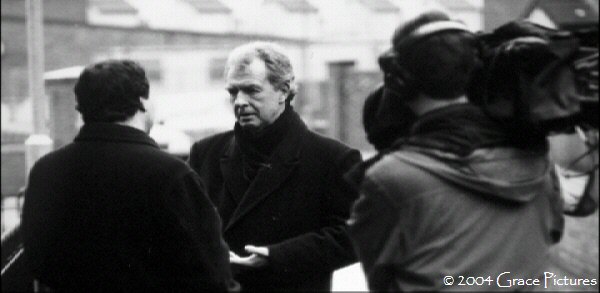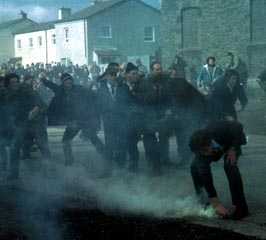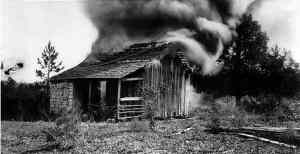|
Through a Glass Darkly: Memories of Bloody Sunday By David Tereshchuk |
|
|
Michael
McHugh/Grace Pictures David Tereshchuk, eyewitness to the 1972 Northern Irish massacre known as Bloody Sunday," during the making of a documentary film exploring his memories. |
|
|
Domingo
Sangriento/Bloody Sunday A gripping moment from "Bloody Sunday," a film my Paul Greengrass, which relived the slaughter of 14 Catholic civilians by British soldiers during a protest march in the City of Derry more than 30 years ago. |
January, 1923. An African-American home in Rosewood, Florida burned by a rampaging lynch mob. The entire community of Rosewood was destroyed. Estimates of mortalities range from eight to several hundred. |
|
By David Tereshchuk How did I really get here? What’s
my true history? How did the past I call mine actually happen? Not long ago I was summoned back to my
old home country, the United Kingdom, to give eyewitness evidence at Tony
Blair’s Tribunal of Inquiry into a Northern Irish massacre that happened over
thirty years ago – the "Bloody Sunday" of January 30th,
1972, when British troops killed fourteen Catholic civilians during a protest
march in the city of Derry. I’d been a callow 23 year-old when I
covered the march and the resulting carnage for British television. Decades
later, I thought recalling the details was not going to be too difficult –
essentially it would be, even taking into account the passage of time and
some haziness that would naturally have set in, just a mechanistic matter of
getting the old grey cells to order up what I could remember and then putting
it in order. It turned out to be altogether more
troublesome – and I wrote about the discomforting experience for the New
York Times Sunday magazine. The paper headlined the piece "An
Unreliable Witness" – which didn’t endear me to Times editors - and an
insightful film-maker, Michael McHugh, tracked me to Derry and back to
produce a remarkable documentary with the same unflattering title. Now,
though, "an unreliable witness" is a label I have come to make
peace with. The whole endeavor started in me a set
of ruminations on the process of journalistic recall - and other modes of
recollection, too - that are still not fully resolved. I was tripped up by a detail. My mind’s
eye told me a soldier I had seen firing in the direction of my section of the
crowd had been wearing a red beret (the distinguishing mark of the Parachute
Regiment, the crack troops who had been unexpectedly ordered into action) but
most of the pictorial evidence, both newsfilm and photos, suggested he must
have been wearing a helmet. I ended up thoroughly confused. I consulted several noted experts on
memory and eyewitness testimony. One of them, psychology professor Elizabeth
Loftus of the Universities of Washington and California, later told me how I
had probably "superimposed" one snapshot recollection over another
in the tumult of gunfire. During the hearing itself one of the three judges
on the Tribunal panel pointed out to me there were other (beret-wearing)
soldiers photographed in the near vicinity, whom I could have been recalling.
Overall, the uncertainty did not detract substantially from the thrust of my
testimony – that the shooting had been unprovoked. But the questionable
recollection surely bothered me. And it was to prove only the beginning
of a widening arc of uncertainty for me and a humbling appreciation of how
little I understand the process by which experiences – especially traumatic
experiences – can work on a reporter’s, or anyone’s, developing
consciousness. I didn’t think at the time that Bloody
Sunday had any special effect on me. I’d already experienced a horribly
one-sided and atrocity-filled war when Pakistani troops savagely attacked
civilian populations as well as some overwhelmed freedom fighters struggling
for the territory that eventually became Bangladesh. And in my first year in
Northern Ireland I’d become accustomed to firefights and being held at
gunpoint by paramilitaries. But soon, as with many in my generation
of reporters who won spurs in "The Troubles" (a typically wry Irish
euphemism, quick to catch on, for the violence) my career took me into other
areas besides those beautiful but scarred Six Counties. I became a Third
World enthusiast, roaming internationally, and across Africa especially.
That’s not to say that I didn’t ever return to Northern Ireland, but whenever
I did, something … and during those years I couldn’t have told you what …
kept me away from that grim stretch of Derry’s Bogside district that had
become a killing field. When, with the turn of the century, the
call for my testimony came up, and the filming of McHugh’s documentary, I
finally met another eyewitness. It was Don Mullan, who had been a fifteen
year-old marcher on the fateful day, and was later catapulted to prominence
when his researches into suppressed testimony (compiled in a 1997 book, Eyewitness
Bloody Sunday: The Truth) helped significantly in persuading Tony Blair
to open his new Inquiry. With Mullan and with other witnesses I met, I
repeatedly found a (for me) unexpected bond. Sudden kinship would develop
with each encounter. Exchanges like "Where were you?
Sure, you must have been just 30 yards from me!" echoed among us. And we
often turned out to share an onerous sense of having unaccountably -- even
somehow unjustifiably -- escaped while others died. But "survivor
guilt" was a phrase that hadn't even occurred to me until it was voiced
by Mullan, who had been (we figured) about 25 yards from me when the shooting
started. Another fellow-witness, Derryman Terence McClements, who had been 17
at the time, said: "My instinct for self-preservation took over and I
ran. I've felt guilty that a fella I knew, two feet from my shoulder, was
shot -- and why was I not shot?" How might such feelings have played out
in my life? I still didn’t know – until, curiously enough, I was in Chicago,
and got thrown a question I wasn’t prepared for. I was taking part in a panel
discussion on the documentary, when I was asked: "What effect has Bloody
Sunday had on your reporting work?" And suddenly it tumbled out. I am by no
means a mass-murder specialist – God forbid – but the record is very telling.
I’ve written in print and for the screen about flower-shows through to summit
conferences, but there is – I realized that evening - an undeniable thread
woven through it all. There I am in 1974, embroiled in
controversy in the pages of The Times of London over Portuguese
colonial soldiers having mown down residents of Wiryamu, a remote village in
Mozambique – a massacre that gained little coverage in the US, although Time
magazine did briefly make a comparison with the 1969 My Lai atrocity in
Vietnam. And I’m on British television pointing
out frame after condemnatory frame of footage that captures South African
policemen firing at schoolchildren during the Soweto uprising of 1976. In the
1980s, for a television history of South Africa’s long struggle, I’m
reconstructing the Sharpeville shootings of 1960, when 69 unarmed anti-apartheid
protestors were gunned down by police. By the 1990s my first national
television documentary in the United States is the (then little-known) story
of a rampage by a KKK-inspired lynch-mob in 1923 that wiped out the
African-American community of Rosewood, Florida. Like it or not, aware of it or not, I
have clearly been drawn back again and again to the haunting narrative of a
powerful, armed group of men taking - initially with complete impunity - the
lives of ordinary citizens. Then finally in the 2000s I am back in
Derry, a citizen myself - not a journalist at all, and using none of the
paraphernalia of a journalist’s craft. I’m a man in a witness-box, telling –
in the face of whatever uncertainties and complex feelings may have
intervened - simply what he believes happened a long time ago. |
|


